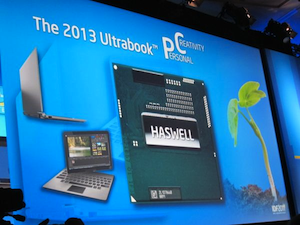Intel Haswell Promises 24h Battery Life
 The trend of new processors increasing performance while decreasing power consumption continues unabated, and Intel just presented just one of the latest examples. On its Intel Developers Conference they demonstrated the new Haswell architecture, to become available in 2013, which will consume so little power that it would allow a notebook based on it to run for 24h on a single charge in use, and whopping 10 days on connected standby.
The trend of new processors increasing performance while decreasing power consumption continues unabated, and Intel just presented just one of the latest examples. On its Intel Developers Conference they demonstrated the new Haswell architecture, to become available in 2013, which will consume so little power that it would allow a notebook based on it to run for 24h on a single charge in use, and whopping 10 days on connected standby.
In fact, the power consumption is so low that the notebook could remain connected to Wi-Fi and fetch updates, emails and sync files even while it’s at sleep since the power available in sleep mode is still enough to run the CPU. This is what “Connected Standby” is about. Basically, the CPU can continue to run even when there is no longer enough battery power to keep the screen lit.
To demonstrate just how little power a Haswell based system needs Intel hooked up a minimal Haswell based system to a tiny solar panel (nearly the size of a postage stamp) and a lamp as its light source. The system was running what appears to be a minimal Windows system in probably a low power consumption mode, but it was enough to power the task manager window and an animated GIF. When they obstructed the light source the system froze, as that immediately cut its only power source.
While this was a minimal system it does demonstrate how far Haswell’s power efficiency has come, and it does open the possibility of having laptops with solar cells embedded on their surface be able to continue running even when battery runs out.
In addition to the ultra low power consumption, which will be a boon to the booming ultrabook market, Intel promises “uncompromising performance”. Haswell uses the 3D tri-gate transistors that are making its debut in the new Ivy Bridge processors to come out next year (which will also significantly improve power efficiency), and will support up to 8-cores. This probably means an increase in performance despite a severe decrease in power consumption by a factor of 20 compared to the current Sandy Bridge architecture.
Haswell seems like a great way to make Intel CPUs competitive in the increasingly mobile oriented computing landscape where ARM based CPUs currently dominate, but they’re not the only ones making inroads. Qualcomm has just announced the new 2.5Ghz quad-core snapdragon CPUs for 2012 which also reduce power consumption while improving performance, and are primarily aimed at tablets.
Significant advances such as this are actually a norm in the CPU industry, and demonstrate an exponential growth of performance per watt. This trend is largely what influences the ongoing rapid shift to mobile computing where ultrabook’s, tablets and smartphones seem poised to take over from desktop PCs and bulky notebooks. It is increasingly becoming possible to put enough power inside of an ultrabook or a tablet to make them into workstation-grade machines.
You can watch the Intel Developer Forum 2011 Keynote here.


Comments - No Responses to “Intel Haswell Promises 24h Battery Life”
Sorry but comments are closed at this time.